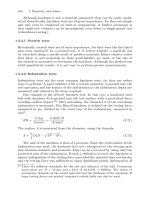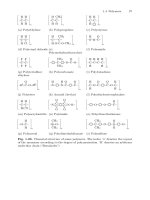Mechanical Behaviour of Engineering Materials - Metals, Ceramics, Polymers and Composites 2010 Part 13 docx

Mechanical Behaviour of Engineering Materials - Metals, Ceramics, Polymers and Composites 2010 Part 13 docx
... http://www.sglcarbon.com/sgl_t/fibers/sigra_c.html. 135 . K. Shiozawa and L. Lu: Very high-cycle fatigue behaviour of shot-peened high- carbon-chromium bearing steel. Fatigue and fracture of engineering materials and structures, 25(8): 813 833, ... mechani- sche Eigenschaften. dlr-fb 9 2-2 8, Deutsche Forschungsanstalt für Luft- und Raumfahrt, 1992. 132 . J. M. Schultz: Pro...
Ngày tải lên: 11/08/2014, 15:20

Mechanical Behaviour of Engineering Materials - Metals, Ceramics, Polymers and Composites 2010 Part 4 docx
... crack-growth resistance or crack-extension resis- tance K IR . 12 The crack-growth resistance initially increases in materials form- ing a process zone, a behaviour frequently denoted R curve behaviour. ... not to depart too far out of the region of smallest cross section. On the one hand, this is due to the smaller stress level in the thicker parts of the specimen. On the other ha...
Ngày tải lên: 11/08/2014, 15:20

Mechanical Behaviour of Engineering Materials - Metals, Ceramics, Polymers and Composites 2010 Part 2 doc
... Dependence of Young’s modulus on the amount of alloyed nickel in cop- p er [33] In table 2.1, a survey of the Young’s moduli of several engineering materials is given. The elastic stiffness of ceramics ... constituting units of polymers. However, it is possible to covalently cross-link the chains, forming a molecular network. These cross-links are crucial in determining the...
Ngày tải lên: 11/08/2014, 15:20

Mechanical Behaviour of Engineering Materials - Metals, Ceramics, Polymers and Composites 2010 Part 5 doc
... figure 6.3. 176 6 Mechanical behaviour of metals (a) Close-packed plane or direction. Slip is relatively easy, as the upper array of spheres has to be lifted only slightly (b) Non-close-packed plane ... lattices. Face-centred cubic crystal The face-centred cubic crystal is close-packed (see section 1.2.2). Planes of type {111} and directions of the type 110 are close-packed an...
Ngày tải lên: 11/08/2014, 15:20

Mechanical Behaviour of Engineering Materials - Metals, Ceramics, Polymers and Composites 2010 Part 6 ppt
... elastically, and the stiffness increases. In the context of fibre- and plate-shaped particles this will be discussed further in chapter 9. The amount of load transfer depends strongly on the shape of the particles and ... exces- sive coarsening of the precipitates. To use high-strength materials at high temperatures, another method of particle strengthening can be achieved by...
Ngày tải lên: 11/08/2014, 15:20

Mechanical Behaviour of Engineering Materials - Metals, Ceramics, Polymers and Composites 2010 Part 7 pptx
... Time-dep endent deformation of polymers 265 (a) Kelvin model (b) Four-parameter model Fig. 8.7. Mechanical models of viscoelastic and viscoplastic materials, built as systems containing spring and ... in thermal expansion of the two materials, the matrix is stressed compressively near the particles, impeding crack propa- 262 8 Mechanical behaviour of polymers T degree...
Ngày tải lên: 11/08/2014, 15:20

Mechanical Behaviour of Engineering Materials - Metals, Ceramics, Polymers and Composites 2010 Part 8 pot
... Araneus diadematus and 8.4 Plastic behaviour 275 Table 8.1. Cross-linking density and Young’s modulus of different types of polymers (cf. section 1.4.2) type of material cross-linking density E/GPa thermoplastics ... chain molecules is larger and enables 9 Mechanical behaviour of fibre reinforced composites In composites, different materials are combined to exploit fav...
Ngày tải lên: 11/08/2014, 15:20

Mechanical Behaviour of Engineering Materials - Metals, Ceramics, Polymers and Composites 2010 Part 9 pot
... application of ceramic matrix composites are cutting tools made of SiC-whisker reinforced aluminium oxide for cutting of hard-to-machine materials, especially nickel- base superalloys and hardened ... enamel. 314 9 Mechanical behaviour of fibre reinforced composites ¾ ¾ ¾ ¾ Fig. 9.11. Deformation of a fibre composite under compressive stress. The fibres can b end in an in-ph...
Ngày tải lên: 11/08/2014, 15:20

Mechanical Behaviour of Engineering Materials - Metals, Ceramics, Polymers and Composites 2010 Part 10 pptx
... glass 40 % C Fig. 10.25. Comparison of the S-N curves of unreinforced as well as glass- and carb on-reinforced polysul fone (simplified plot after [29]) S-N curves of fibre composites According to section ... consequence of what we discussed above concerning the mean-stress dependence of ∆K th , ∆K Ic , and da/dN . In equa- tion (10.8), this shift of the curve is accounted for...
Ngày tải lên: 11/08/2014, 15:20
- ceramics polymers and metals
- metals polymers and ceramics
- properties of 25 materials most commonly used in mechanical design
- mechanical properties of metals and alloys
- cardiff school of engineering
- the mechanical properties of fibermatrix interfaces
- the standard handbook of engineering calculations
- basic pricinples of developing materials of teaching language